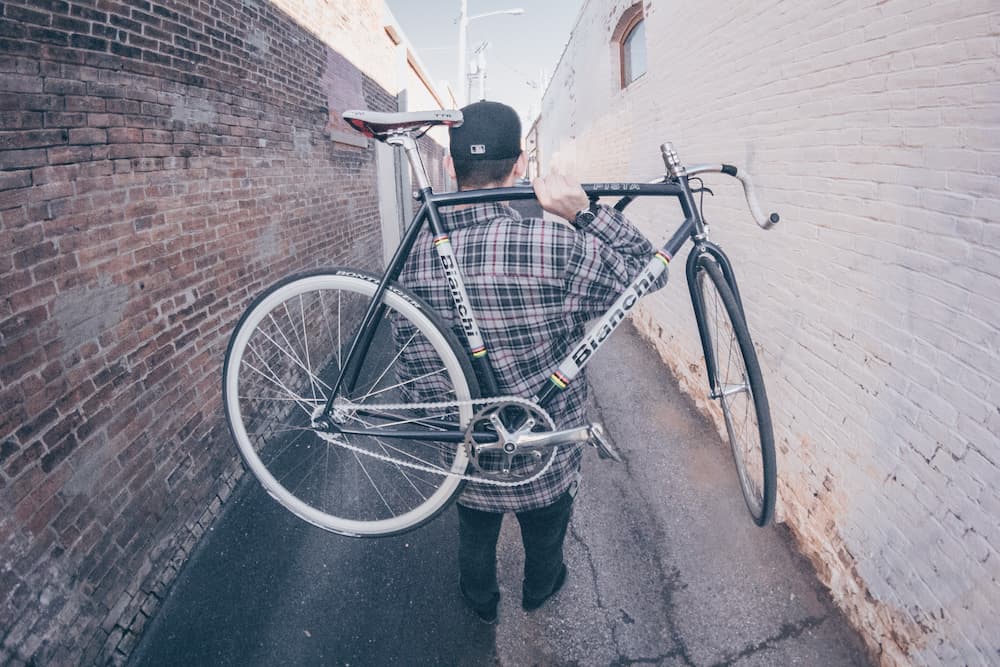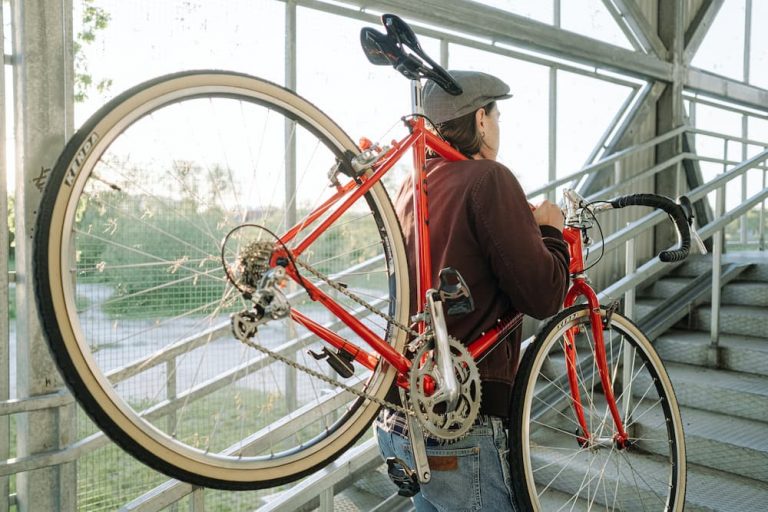How To Carry Bike on Your Back?
Why would you put weight on your shoulders when your legs are there to pedal away? Unfortunately, there will be times when you can only get your bicycle to your destination on your back!
Whether you plan on taking your bike up a flight of stairs or climbing a mountain, you’d need to know how to properly carry a bike on your back. This is especially true if you’ve to cross a steep slope, then you can’t just start cycling and hope for the best.
As annoying as this may sound to you, hikers have made a habit of carrying their bicycles on their backs. Hikers say it’s liberating if anything!
To make it easier for you to carry your ride on your back, we’ve listed a few options you can use if your bicycle tires are blown out and you want to walk with your bike.
Contents
How To Carry Your bicycle On Your Back?

So let’s take a look at how you can easily carry your cycle on your back.
Step 1
The first step if you want to carry your bicycle on your back is to do a safety check. For one, you need to make sure you’re fit enough to carry your bike and bear the weight without hurting yourself.
A regular weighs about 17 or 18 pounds, more if you add gears and panniers. If you’ve injuries or can’t carry the weight on your shoulders, you’ll need to think of other ways to get your bike to its destination – and we promise there are many!
Step 2
Aside from your physical safety, you should be far away from the chainrings. You should put the chain on one of the chainrings, preferably a bigger one. This would be possible if your bike had more than one chainring.
Step 3
When you stand with your bike on its side, position it so that the drivetrain isn’t facing you. You can also face it so that the pedal or crank arm is clearly facing you. The position can be accurately described as 6 o’clock from you.
Positioning the bike before picking it up is also crucial for weight management and arm extension.
Step 4
Next, squat down a bit before placing your hands on the bike. When you squat, make sure your feet are shoulder-width apart.
You can either use the crank arm and fork or the saddle nose and handlebars.
If you just put your left hand on the bottom of the saddle and the other arm on the handlebars, you can still lift the bike easily.
To lift your bike off the ground, you must place one hand on the crank arm or the underside of the saddle nose.
It’s also a good idea to rest the top tube on your shoulders while your hands are on the handlebars. Then turn the bicycle around and place it around your neck.
Next, adjust the height of the seat post and raise it so you can get a good grip on it. This method is preferred because it’s much easier to keep your back on the ground.
Step 5
When you squat down, remember to set your legs shoulder-width apart so that you can use your legs better. Using all the strength of your legs, set the bike up so that the down tube rests on your shoulder.
One way to save your shoulders is to use a backpack or back carrier during this step. This may sound like extra weight, but a backpack can take the actual weight off your shoulders. If you use a backpack, you can also put the down tube over the head of the backpack.
You can also rest the top tube on your shoulder while resting one arm on the seat post and the other on the saddle.
Step 6
Next, it’s about how you prefer to carry your bicycle on your back. This means customizing your bike to fit your needs. One option that works well for many is to have the bottom bracket near the neck. This way, your bike can be better centered.
However, depending on your build and your bicycle’s frame, you can change the position until you feel like your bike fits well.
Step 7
Once you’re done with the bicycle on your back, remember to walk steadily, slowly, and carefully as you head down the road or up the hills.
Portaging Backpack System
Portaging backpacks are designed for carrying bikes on your back. These are not your regular cycling backpacks. They consist of a base pack, including the shoulder and waist straps and magnetic Fidlock posts. The posts and straps together secure the backpack to your back.
The bags also come with an aluminum frame bicycle module that includes hooks for attaching your bike. The rubber coatings are grippy and can be resized. That means no matter what size your bike frame is, the hooks can easily secure your bike. In addition, the Fid lock attachments can be connected to the bike.
After you snap the locks and hooks into place, strap on the shoulder and waist straps for more protection and stability. Now all you’ve to do is wear your backpack and carry your bicycle.
How Do I Carry A Mountain Bike On My back?
Whether you’re riding on flat or steep terrain, carrying a mountain bike on your back is different than carrying a regular bike. Mountain bikes are sturdier compared to most other types of bicycles, and have flatter and wider frames and handlebars.
If you’ve ever ridden a mountain bike, you know that it’s quite difficult to pedal before you get used to it. The weight of the mountain bike is another issue when it comes to carrying it on your back. A mountain bike can weigh about 10 to 12 pounds more than a regular bicycle, so it needs to be carried with more caution.
When carrying a mountain bike on your back, it’s best to use the crank and fork combination to place your hands. With the crank facing you, place one hand on the crank arm, and you can place the other hand in one of the fork feet. Choose the fork that’s easiest to reach
Next, squat all the way down on the ground so you can lift the heavier load compared to regular bikes at 18 pounds. You can lift the bike over your head and place it on your backpack or shoulder.
Since the frame is heavier, it’s best to distribute the weight of the bike on the bag.
A backpack also helps to make the weight distribution of the bike more stable and create more stability.
Pedal harder, keeping your balance more forward as you already have loads that shift your center of gravity slightly.
However, you should note that it can also be difficult to lift the mountain bike off your back. Therefore, you should use the strength of your hands to lift your bicycle as high as possible before you put it down so that it doesn’t fall on your head or helmet.
Final Thoughts
If you’re looking for ways to carry your bicycle on your back, we’ve something for you. You should keep in mind that mountain bikes are different, and you’ll have to make a different effort to carry them on your back. However, the basic rules for carrying a bicycle on your shoulder remain the same no matter what frame you carry.
Walking or climbing steadily is just as important when you’re carrying a bike on your shoulders. That being said, keep in mind that it’s easier to turn your bike onto your shoulder than to lift it directly off the ground. In any case, make sure you don’t hit your head.






